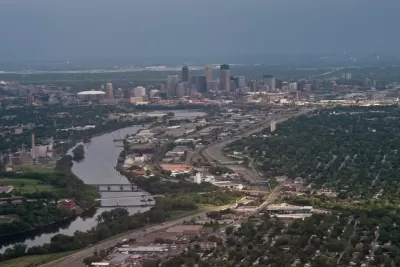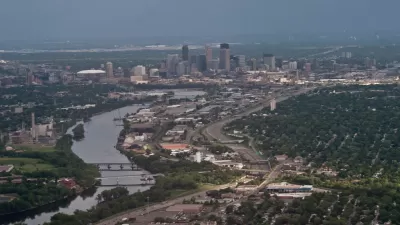A plan for 48 acres of riverfront land could make Minneapolis a leader in doing redevelopment right, argue city leaders.

The Minneapolis City Council on Friday approved a plan for the Upper Harbor Terminal, an industrial riverfront area north of downtown. Ahead of an earlier city council committee vote on the plan, Mayor Jacob Frey and Phillipe Cunningham, a member of the city council, made the case for the redevelopment project:
The sustained exclusion from opportunities afforded by the riverfront is a sad legacy that we simply must change. Done right, redevelopment of the Upper Harbor Terminal holds the opportunity to ensure that current residents benefit, that the area’s economy thrives and that the north Minneapolis riverfront is highlighted in deserving fashion.
The concept plan includes a performing arts center, green space, housing, a business center, and a utility hub. The plan, argue Frey and Cunningham, reflects an approach that ensures equity is part of the redevelopment process and demonstrates how other cities can maximize public investment while also addressing longstanding economic inequality.
"With 41 percent of the land designated for park use, plans for new employment opportunities, more affordable housing and a signature concert venue, Minneapolis has a chance to create a national model for equitable economic development that stabilizes community while expanding riverfront access," say Frey and Cunningham.
The plan has been controversial, with community and environmental advocates outlining a series of concerns about privatization of land, restricted public access to green space, and gentrification effects on surrounding neighborhoods.
Frey and Cunningham say they are committed to a collaborative planning process that will directly involve the community. "This is an undertaking of historic proportions, and part of changing history means we put north Minneapolis first and make sure North Side residents are involved in the planning process."
FULL STORY: Minneapolis development and economic equity: Upper Harbor Terminal can be a national model

Study: Maui’s Plan to Convert Vacation Rentals to Long-Term Housing Could Cause Nearly $1 Billion Economic Loss
The plan would reduce visitor accommodation by 25,% resulting in 1,900 jobs lost.

North Texas Transit Leaders Tout Benefits of TOD for Growing Region
At a summit focused on transit-oriented development, policymakers discussed how North Texas’ expanded light rail system can serve as a tool for economic growth.

Why Should We Subsidize Public Transportation?
Many public transit agencies face financial stress due to rising costs, declining fare revenue, and declining subsidies. Transit advocates must provide a strong business case for increasing public transit funding.

How to Make US Trains Faster
Changes to boarding platforms and a switch to electric trains could improve U.S. passenger rail service without the added cost of high-speed rail.

Columbia’s Revitalized ‘Loop’ Is a Hub for Local Entrepreneurs
A focus on small businesses is helping a commercial corridor in Columbia, Missouri thrive.

Invasive Insect Threatens Minnesota’s Ash Forests
The Emerald Ash Borer is a rapidly spreading invasive pest threatening Minnesota’s ash trees, and homeowners are encouraged to plant diverse replacement species, avoid moving ash firewood, and monitor for signs of infestation.
Urban Design for Planners 1: Software Tools
This six-course series explores essential urban design concepts using open source software and equips planners with the tools they need to participate fully in the urban design process.
Planning for Universal Design
Learn the tools for implementing Universal Design in planning regulations.
City of Santa Clarita
Ascent Environmental
Institute for Housing and Urban Development Studies (IHS)
City of Grandview
Harvard GSD Executive Education
Toledo-Lucas County Plan Commissions
Salt Lake City
NYU Wagner Graduate School of Public Service




























